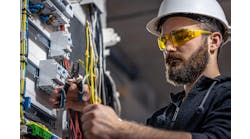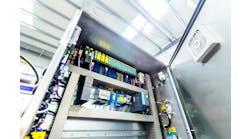A Control Design reader asks: I'm a recent college graduate and controls engineer at a system integrator who specializes in remote monitoring and process skid design, so I'm constantly selecting control enclosures for a variety of applications from office-like environments to outdoors in the rain and hot sun. I'm trying to standardize on a single enclosure type, but that doesn't seem possible. While stainless steal is great, it is expensive, and, while plastic works well, I find cracks or holes smashed in the doors of the enclosures at remote sites.
Obviously, the size of the enclosure is important, but what are some other considerations when selecting an enclosure, and what are some common mistakes I should watch out for? I don't want to purchase 100 enclosures that crack, melt, rust or otherwise are not suitable for the application. What do you think? Just get a battleship gray, NEMA 12 enclosure and hope for the best?
ALSO READ: Control panel design starts with the basics
Answers
Dimensions and environment
This is a battle we’ve been fighting for decades. The key to driving production consistency and end-product availability is standardizing your enclosure dimensions and environmental ratings wherever possible.
Indoor Type 1 general purpose enclosures have advantages, such as knockouts for easier installation of pilot operators and conduit entry. However, as environments get dustier, Type 12 enclosures come into play. With washdown or hose-down applications, material type and size become very important. Certain washdown chemicals can erode and cause cracking to polycarbonate or fiberglass enclosures if material types are not selected appropriately. Stainless steel, polycarbonate and fiberglass can become costly, especially with larger enclosure dimensions. Type 4 painted steel enclosures are typically a good compromise for most applications as they cover 1, 12 and 3R enclosures.
Wall mounts are optimal for cabinets up to 50 inches tall. Cabinets that are taller than this may run into installation issues. Enclosures taller than 50 inches are ideal in a floor-standing construction, which allows for features like baying multiple enclosures, removable conduit-entry gland plates and side walls for easier access. Keep in mind that Type 4 UL testing is very aggressive and can increases costs for floor-standing enclosures. Typically, Type 3R are much more cost competitive in floor-standing, 50-inch enclosures and higher.
Standardizing on Type 4 is probably the best solution for enclosures smaller than 50 inches tall, and Type 3R is best for floor-standing or larger enclosures. If cost is your main concern, Type 1 will be your strongest contender for general-purpose indoor. The 4X applications will need more caution in the selection process as it will depend on the chemicals present.
Ahmad Omari
Product manager
Rockwell Automation
True costs
It’s wise to explore all the enclosure materials and options. There is not one solution for all environments.
With the variety of materials available for enclosures, it is important to look at the true cost, not just acquisition, but use and operating costs. A plastic enclosure, in your example, which needs to be replaced from damage in remote sites, may have a lower acquisition cost, but higher use and operating costs. A balance between economics, utility and performance can ensure the ROI of the investment.
It sounds like you have considered the environmental exposure your enclosures will be subject to. Corrosive stress occurs even in benign installations, where even water and oxygen can be mildly damaging. In addition to the corrosive elements present, remember the byproducts such as wastewater and steam can also pose a threat.
Of the different enclosure materials available, stainless steel provides the longest lifespan for indoor/outdoor rating. But even here, with Type 304 or Type 316, you have some flexibility for your industry. In general, stainless steel delivers consistent performance in virtually all environments, but it is a more expensive material. Carbon steel, on the other hand, is less expensive, but its corrosion protection relies on the maintained integrity of the enclosure paint/coating. This should always be considered for any outdoor application involving carbon steel enclosures.
A good source of information is the NEMA 250 standards publication, which provides data that can permit a potential user to determine the type of enclosure appropriate for the application. Keep in mind that some enclosure manufacturers apply multiple ratings (for example, NEMA 12 and 4) to the enclosure to allow for greater flexibility during the specification and selection process.
Other aspects of the enclosure, such as gasketing and grounding, are sometimes overlooked in the specification process. Foreign substances entering the enclosure can ruin your equipment so features such as foam-in-place gaskets deliver a tight, continuous seal. Since safety is always a primary concern, enclosures that ground the enclosure through grounding straps, or, better yet, through the smart use of integrated/ automatic system grounding in the panels and plates, create an optimal safety environment.
Scalability in your enclosures assures that, as your center expands, you can easily adapt. Choose a modular enclosure which can be bayed side-to-side, back-to-back or side-to-back. Knowing your enclosure can adapt to infrastructure changes extends its lifetime and usage costs.
Once you have narrowed down your enclosure selection, drill down into hidden costs. Take into account the time required for assembly and integration. Some enclosures require no specialized training, while others require fabrication techniques (cutting/welding/bending) to modify the enclosure. Compare the mounting panels. Are they accessible from the front, side, back? Can accessories be easily added? If extensive modifications need to be made, what will the labor/maintenance cost be?
Keep your true cost in mind during your selection process. When specifications for control panels and other applications are written, the true costs and benefits of utilizing one enclosure solution over another must be fully considered—especially in today’s economic climate where every penny counts. Consider not only your current needs but project and account for your future expansion. Either you or another member of your team will be looking at power, cooling and accessory/rack options. When you bring all these factors into the decision, you’ll find the right answer for your company.
Troy Miesse
North American product management, enclosures
Rittal
Standardize on a standard size
Enclosure selection is an important element when developing control solutions. It increases the reliability of the system, reduces maintenance and ensures the life expectancy of the components installed.
To make the proper selection of a control enclosure, it is necessary to first consider environmental factors. The environment can create multiple sources of risk for equipment to fail; for example, solar heat, humidity/condensation, rain, snow and other adverse climates factors. All these factors will determine the level of protection required.
The next step will be the sizing of the enclosure. The ideal scenario is to have the most accurate bill of materials together with a 3D modeling software. Make sure that you always select standard-sized enclosures that allow you to have alternatives when considering different enclosure materials. By standardizing your enclosure size, you create the ability to select multiple vendors who can offer more competitive solutions.
Furthermore, make sure your enclosure always maintains a suitable working temperature. Certain electric components can generate high amounts of heat; when combined with adverse climate, this could lead to a situation in which heat-sensitive components fail. If required, a cooling or heating element should be installed accordingly. Furthermore, if you perceive uncertainty in your application, it is also a good idea to consider some extra room for your enclosure to grow.
Regarding standardization, the type of enclosure is always associated with the protection option. For NEMA 4X protection type, stainless steel is only one option available. You can also explore aluminum, fiberglass or polycarbonate enclosures. Restrictions must be considered in terms of size, structural rigidity and functionality, but each alternative could help you to deliver the protection required while staying in budget.
Carlos Ojeda
Project engineer for customer solutions
Festo
FMEA to define requirements
Your question on enclosure selection is interesting in that it is a question of reliability/durability and total cost of ownership. Based upon your comment that stainless steel is expensive, you imply that the design and application are not cost insensitive. Picking a battleship gray NEMA 12 enclosure is a valid option, but since NEMA 12 is rated for indoor use, you will be over-designed for some applications and may still be under-designed in others,. The idea of standardizing is a good one; however, you describe a vast range in environments. Unless you accept the cost of design for the worst case, you cannot really achieve a single enclosure design independent of the system design. I would suggest that you do an assessment of the different applications and their environments. You can then develop a standardized enclosure to support each environment as a first step. You can then work with your system designers and see if you can provide structure to support your enclosure in the more harsh environments to allow you to start to standardize the enclosures. I would suggest that you develop a failure mode and effects analysis (FMEA) for your different applications as this will help you clarify the enclosure failure mechanisms and allow you to define the enclosure requirements.
Daniel C. Conrad, Ph.D., CRE,
Director of reliability & testing
Step by step
Probably the most important thing is, first, they need to evaluate the environment the enclosure is going in—outdoor/indoor.
You must make sure you select a material type that withstands the environmental conditions. It could be galvannealed/galvanized, carbon steel powder coated, stainless steel 304 or 316, polycarbonate or fiberglass.
Next, determine what type of rating/seal you want or need on the enclosure—NEMA 4X, NEMA 4, NEMA 12, NEMA 3R, NEMA 1. Once this is determined, it is always most cost effective to look at manufacturers’ standard sizes. Standardization often helps with cost and lead time/availability.
Another important factor is that sunlight plays a huge role in an enclosure’s performance, especially when putting a sealed NEMA 4/4X enclosure in an outdoor environment where rain/sleet/snow is present. Maybe people do not know, but, if you stick an enclosure in the sun, the internal temperature vs. external temperature can create huge issues.
For example, put an enclosure outside in the sun and you may have the inside temperature easily reach 120 °F on a hot 90 °F summer day. If a sudden rainstorm blows in and cools the air down to 60 °F, now you’ve created a huge difference from inside to outside temperature. The enclosure inside starts to cool down quickly, causing the air molecules inside the enclosure to contract creating a vacuum type effect on a sealed enclosure. Somehow someway, the enclosure must neutralize the pressure from outside to inside and ends up pulling air/moisture/water through the weakest link, which is typically going to be some point along the gasketing/seal around the door. In this scenario, it doesn’t matter whose enclosure you are using; this can and does happen often. That is why, in outdoor applications where a NEMA 4 or 4X enclosure is used, we always recommend using a UL approved NEMA 4/4X-rated drain/breather vent. In reality these probably only get installed on 5-10% of the enclosures that should be getting one.
Also, the ratings are often geared toward a type of industry:
- NEMA 3R = often in the agriculture/pumping industries
- NEMA 12 = typical industrial plant where dust, debris and oils are present
- NEMA 1 = typically found in clean rooms/houses/environments when there is not dust/debris around
- NEMA 4 = many outdoor applications where harsh chemicals and sale spray are not present
- NEMA 4X = food and beverage, near salt water, off shore, wastewater, any type of washdown environment; consider environment to decide between 304/316 stainless steel and fiberglass/polycarbonate.
There are many factors that go into selecting an enclosure, but these are probably the things that are missed the most.
Scott Baldauf
Vice president of sales & marketing
Saginaw Control & Engineering
Consider the four elements
I understand a desire to standardize, but please know it is really not a viable solution. For instance, no one vehicle—from a Mack dump truck to a Chevy Corvette—is suitable for all transportation needs.
When selecting an enclosure for any electrical application, there are four critical elements to consider, those being location, environment, contents and size.
Location and environment: First you must determine if the enclosure will be located indoors or outdoors, and in either instance if it will be subjected to hose-down, rain, excessive dust or corrosive elements.
Determination of these factors will guide you toward a suitable rating and material.
In this instance, the most common mistake is overlooking or not being aware of an element of the environment that may do damage either to the box or the equipment within.
Contents: Next, you must determine if the prevailing environment around the enclosure will damage the equipment within the enclosure unless the enclosure is pressurized. You must also consider if the equipment is sturdy or delicate in any respect.
In this instance, the most common mistake is overlooking or not being aware of particular devices within the enclosure that cannot stand excessive cold, heat or corrosive atmospheres.
Size: Finally you must determine if you can find a size and shape that meets your needs, or if a custom fabricated enclosure is necessary.
In this instance, the most common mistakes revolve around two-dimensional layouts that do not show overlapping equipment that is occupying the same space (what we call “collidus”) and/or a lack of spare space to accommodate future needs and permit free ventilation with the enclosure.
NEMA Standard 250 provides a full range of enclosure ratings that most manufacturers follow, to offer a wide variety of shapes and sizes in a variety of materials that will be suitable for a particular location and environment.
Once a NEMA rating is determined, you can then easily browse to find multiple manufacturers of an enclosure rated to meets your needs, and then among them you can find reasonable variations to address secondary concerns like ergonomics or security.
You then need only provide a suitable environment within the enclosure by adding ventilation, heating, cooling and/or filtration as necessary to ensure the longevity of the components you place within the box.
Mike Baucom
Executive director
Bebco Environmental Controls
Mike Bacidore is the editor in chief for Control Design magazine. He is an award-winning columnist, earning a Gold Regional Award and a Silver National Award from the American Society of Business Publication Editors. Email him at [email protected].






